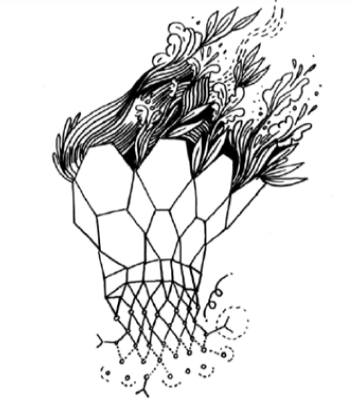
“They have no light of dawn. … only distress and darkness and fearful gloom.” (Isaiah 8:20c, 22a NIV); “The people walking in darkness have seen a great light; on those living in the land of deep darkness a light has dawned.” (Isaiah 9:2 NIV)
These two texts, next to each other, may be the biggest color-contrast of all. The end of Isaiah 8 is colored a dark shade. It shows harried people, willing to turn everywhere but to God, ensnared in darkness. The beginning of Isaiah 9, on the other hand, is multispectral brightness. God gives them yet another child, a gift of light.
Isaiah 8’s dark images are captured best by the King James Version: people seek “familiar spirits,” “wizards that peep, and that mutter,” “there is no light/morning in them,” they “pass through” the land, “hungry,” they “fret themselves.” They only look up to curse, and look down to “behold trouble and darkness, dimness of anguish, and they shall be driven in darkness.”
Drivenness, anxiety, desire, and pain. These feelings were familiar thousands of years ago and remain familiar today (like “Hurry! Hurry!” from the first part of Isaiah 8). We are deep in the valley of the shadow of death, and it’s the same as the one in the most famous of all psalms. Isaiah 9:2 uses the exact same Hebrew word, “tsalmaveth,” as Psalm 23:4, “Though I walk through the valley of ‘tsalmaveth’…. .’
Some ancient Hebrews used “tsalmaveth” for Hell. The NIV translates this word as “deep darkness” but it’s literally “the shade of death.” It’s used an astonishing 10 times in Job. This is the word for your lowest point, your darkest night, when everything’s taken away and you sit with no hope.
This oppressive darkness can fall on you like a stormcloud blotting out the sun, or it can creep into you through the little disappointments that pile up. One little disappointment I still remember from when I was little: as a child I tried to make green from my crayons, by mixing blue and yellow. But I only made murky brown, and the harder I tried, the farther from green I got. This might be the first time when I found that trying harder just made things worse. (It was not the last.)
I learned through experience that pigments don’t produce light, they reflect it. So, when you mix more crayon pigments together, less and less light is reflected, and the colors get muddier and darker. All the efforts and feelings of Isaiah 8:19-22 are like those crayon colors, just getting darker as the stuff piles on.
But when I mix light itself, the opposite’s true. You can do this with colored flashlights, if you’re normal, but me, I’m a chemist, so I did it by cutting open a bunch of cheap glow-sticks. The luminescent molecules in these don’t reflect light, they produce it.
With these in my kitchen, I fulfilled my childhood dream and mixed yellow and blue to make fluorescent green. It was impossible with crayons but possible with these. When I mixed all the colors together, I made a warm white light, one that still holds echoes of all the original colors in it, like a bright flame but cool to the touch. I found this oddly soothing, and kept the tubes by my desk till the light faded.
Pigments mix by subtraction, but light mixes by addition. These are fundamentally different types of mixing, and that makes all the difference. God is an artist, and His favorite medium must be light itself. He spoke “let there be light” and made the universe, after all.
To the people walking in the valley of the shade of death, Isaiah 9:2 predicts, “light shall shine upon you.” In Greek this reads “phos lampsei,” which are the exact words Paul uses in 2 Corinthians 4:6 when he says “the God who says ‘Light shall shine out of darkness’ is the one who has shone in our hearts.” (David Bentley Hart’s translation) God’s light mixes additively with us, illuminating us when we get our subtractive darkness out of the way.
This is why we sing in the Sussex Carol, “All out of darkness we have light which made the angels sing this night.” Even in the valley of the shade of death, God is said “phos lampsei,” “light shall shine” in Jesus. This darkness is the context of “For Unto Us a Child is Born,” and this light is its subject. The child is a great light (“mega phos” in Greek) that shines through the darkness.
The Third Child will be named with so many names that they will jumble together, each with its own color, adding brightness to brightness, combining to make a great, “mega-phosphorescent” light. This text holds many colors of light, and they all mix to brightness. This is what those of us in darkness right now desperately need – the Light of the World Himself.
